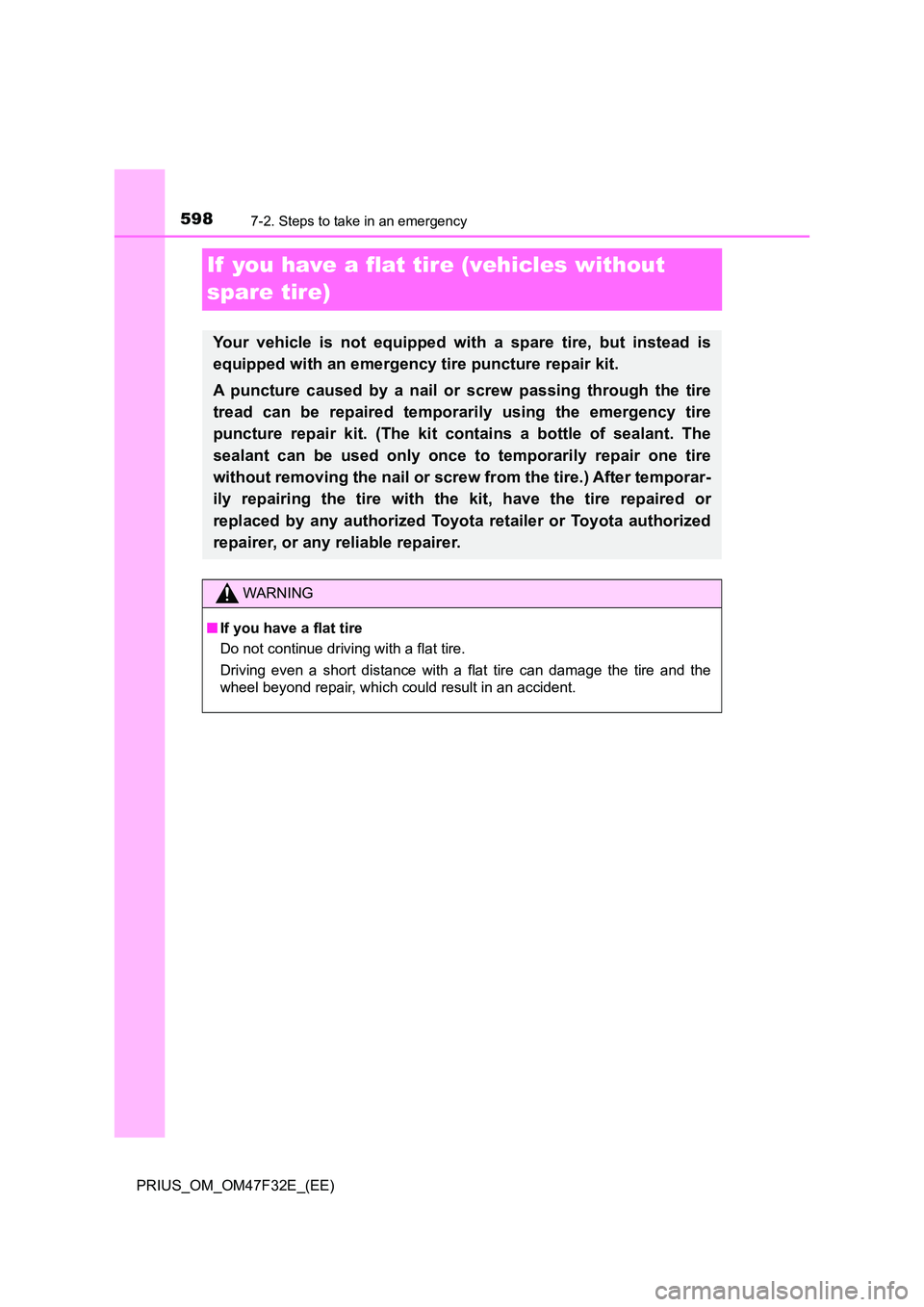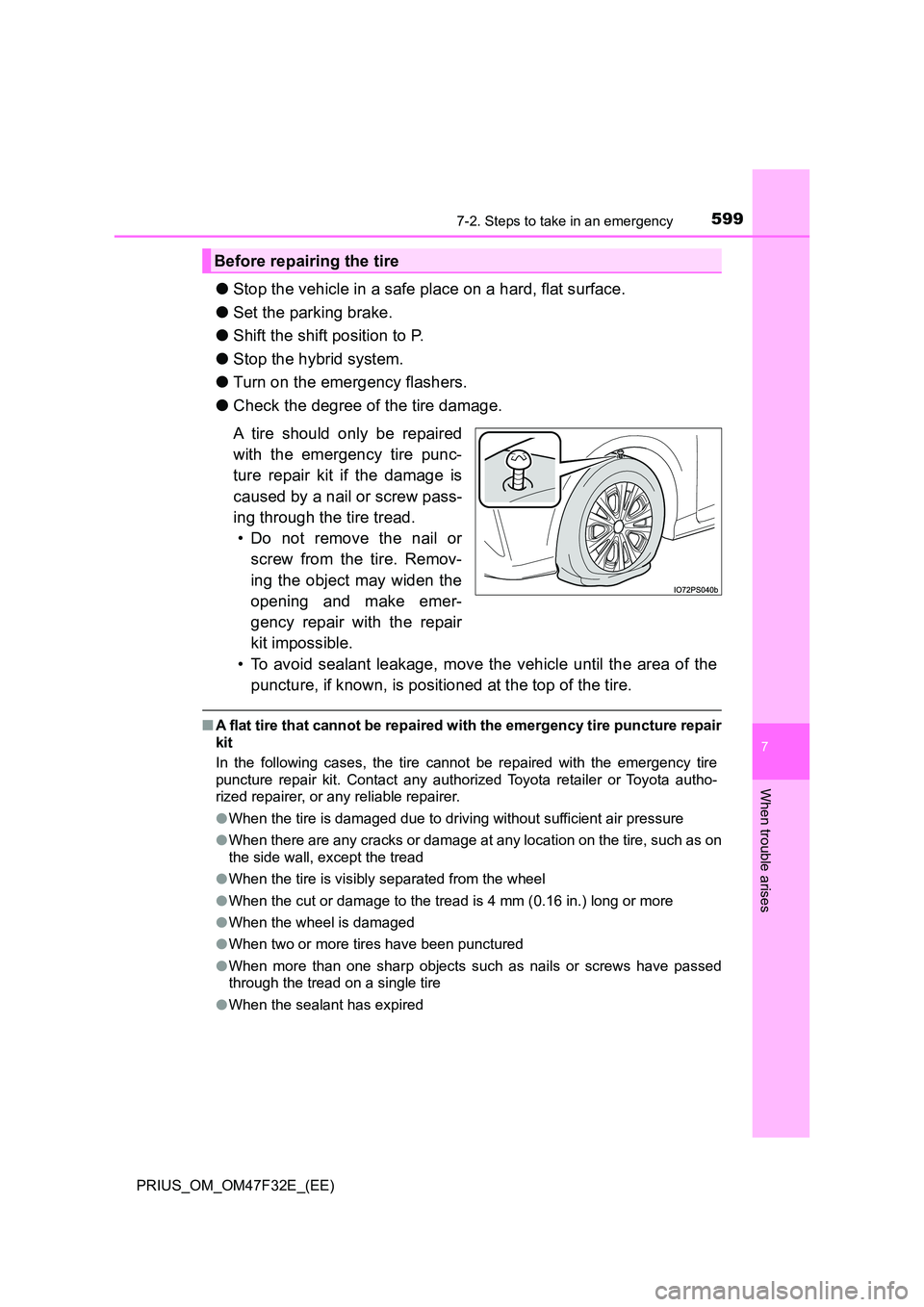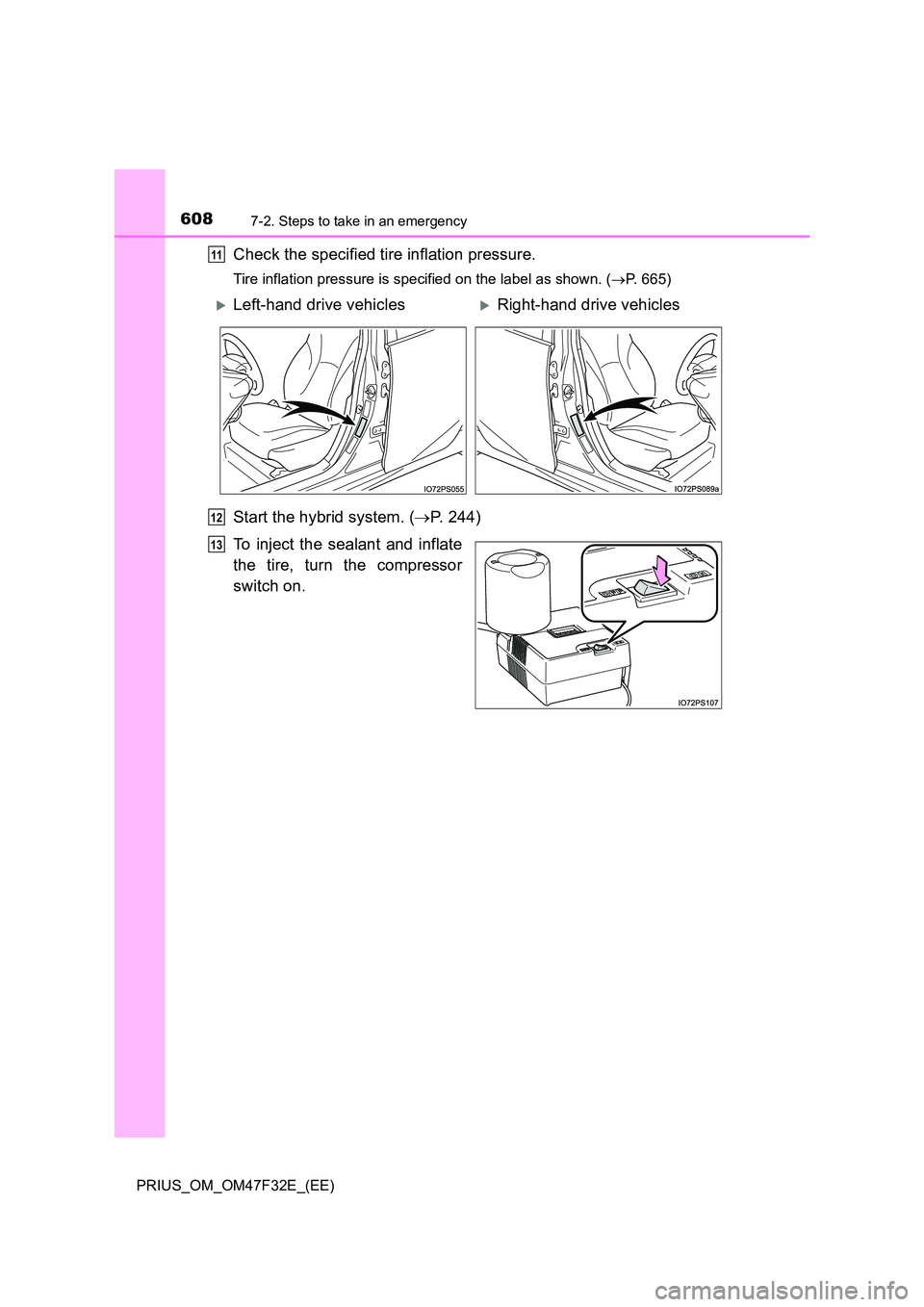2023 TOYOTA PRIUS flat tire
[x] Cancel search: flat tirePage 588 of 770

5867-2. Steps to take in an emergency
PRIUS_OM_OM47F32E_(EE)
*5: Rear passengers’ seat belt warning buzzer:
The rear passengers’ seat belt warning buzzer sounds to alert the rear
passenger that his or her seat belt is not fastened. If the seat belt is unfas-
tened, the buzzer sounds intermittently for a certain period of time, after
the seat belt is fastened and unfastened and the vehicle reaches a certain
speed.
*6: This symbol is displayed on the multi-information display.
■ Front passenger detection sensor, seat belt reminder and warning
buzzer
● If luggage is placed on the front passenger seat, the front passenger detec-
tion sensor may cause the warning light to flash and the warning buzzer to
sound even if a passenger is not sitting in the seat.
● If a cushion is placed on the seat, the sensor may not detect a passenger,
and the warning light may not operate properly.
■ Electric power steering system warning light (warning buzzer)
When the 12-volt battery charge becomes insufficient or the voltage tempo-
rarily drops, the electric power steering system warning light may come on
and the warning buzzer may sound.
■ If the malfunction indicator lamp comes on while driving
For some models, the malfunction indicator lamp will come on if the fuel tank
becomes completely empty. If the fuel tank is empty, refuel the vehicle imme-
diately. The malfunction indicator lamp will go off after several trips.
If the malfunction indicator lamp does not go off, contact any authorized
Toyota retailer or Toyota authorized repai rer, or any reliable repairer as soon
as possible.
■ When the tire pressure warning light comes on (if equipped)
Inspect the appearance of the tire to check that the tire is not punctured.
If the tire is punctured: P. 598, 618
If the tire is not punctured:
Carry out the following procedure after the tire temperature has lowered suffi-
ciently.
● Check the tire inflation pressure and adjust to the appropriate level.
● If the warning light does not go out even after several minutes, check that
the tire inflation pressure is at the specified level and carry out initialization.
( P. 531)
The warning light may come on again if the above operations are conducted
without first allowing the tire temperature to lower sufficiently.
Page 589 of 770

5877-2. Steps to take in an emergency
PRIUS_OM_OM47F32E_(EE)
7
When trouble arises
■The tire pressure warning light may come on due to natural causes (if
equipped)
The tire pressure warning light may come on due to natural causes such as
natural air leaks or tire inflation pressure changes caused by temperature. In
this case, adjusting the tire inflation pressure will turn off the warning light
(after a few minutes).
■ When a tire is replaced with a spare tire (vehicles with the tire pressure
warning system)
Vehicles with compact spare tire: The compact spare tire is not equipped with
a tire pressure warning valve and transmitter. If a tire goes flat, the tire pres-
sure warning light will not turn off even though the flat tire has been replaced
with the spare tire. Replace the spare ti re with the repaired tire and adjust the
tire inflation pressure. The tire pressure warning light will go off after a few
minutes.
Vehicles with full-size spare tire: T he spare tire is also equipped with a tire
pressure warning valve and transmitter. The tire pressure warning light will
turn on if the tire inflation pressure of the spare tire is low. If a tire goes flat,
the tire pressure warning light will not turn off even though the flat tire has
been replaced with the spare tire. Replace the spare tire with the repaired tire
and adjust the tire inflation pressure. The tire pressure warning light will go off
after a few minutes.
■ Conditions that the tire pressure warning system may not function prop-
erly (if equipped)
P. 533
■ If the tire pressure warning light frequently comes on after blinking for
1 minute (if equipped)
If the tire pressure warning light frequently comes on after blinking for
1 minute when the power switch is turned to ON mode, have it checked by
any authorized Toyota retailer or Toyota authorized repairer, or any reliable
repairer.
■ Warning buzzer
In some cases, the buzzer may not be heard due to being in a noisy location
or audio sound.
Page 590 of 770

5887-2. Steps to take in an emergency
PRIUS_OM_OM47F32E_(EE)
WARNING
■When the electric power steering system warning light comes on
When the light comes on yellow, the assist to the power steering is
restricted. When the light comes on red, the assist to the power steering is
lost and handling operations of the steering wheel become extremely
heavy. When steering wheel operations are heavier than usual, grip the
steering wheel firmly and operate it using more force than usual.
■ If the tire pressure warning light comes on (vehicles with the tire pres-
sure warning system)
Be sure to observe the following precautions. Failure to do so could cause a
loss of vehicle control and result in death or serious injury.
● Stop your vehicle in a safe place as soon as possible. Adjust the tire infla-
tion pressure immediately.
● Vehicles with emergency tire puncture repair kit: If the tire pressure warn-
ing light comes on even after tire inflat ion pressure adjustment, it is proba-
ble that you have a flat tire. Check the tire s. If a tire is flat, repair the flat tire
by using emergency tire puncture repair kit.
● Vehicles with spare tire: If the tire pressure warning light comes on even
after tire inflation pressure adjustment, it is probable that you have a flat
tire. Check the tires. If a tire is flat, change it with the spare tire and have
the flat tire repaired by the nearest any authorized Toyota retailer or Toyota
authorized repairer, or any reliable repairer.
● Avoid abrupt maneuvering and braking. If the vehicle tires deteriorate, you
could lose control of the steering wheel or the brakes.
■ If a blowout or sudden air leakage should occur (vehicles with the tire
pressure warning system)
The tire pressure warning system may not activate immediately.
NOTICE
■ To ensure the tire pressure warning system operates properly (vehi-
cles with the tire pressure warning system)
Do not install tires with different specif ications or makers, as the tire pres-
sure warning system may not operate properly.
Page 600 of 770

5987-2. Steps to take in an emergency
PRIUS_OM_OM47F32E_(EE)
If you have a flat tire (vehicles without
spare tire)
Your vehicle is not equipped with a spare tire, but instead is
equipped with an emergency tire puncture repair kit.
A puncture caused by a nail or screw passing through the tire
tread can be repaired temporarily using the emergency tire
puncture repair kit. (The kit contains a bottle of sealant. The
sealant can be used only once to temporarily repair one tire
without removing the nail or screw from the tire.) After temporar-
ily repairing the tire with the kit, have the tire repaired or
replaced by any authorized Toyota retailer or Toyota authorized
repairer, or any reliable repairer.
WARNING
■ If you have a flat tire
Do not continue driving with a flat tire.
Driving even a short distance with a flat tire can damage the tire and the
wheel beyond repair, which could result in an accident.
Page 601 of 770

5997-2. Steps to take in an emergency
PRIUS_OM_OM47F32E_(EE)
7
When trouble arises
●Stop the vehicle in a safe place on a hard, flat surface.
● Set the parking brake.
● Shift the shift position to P.
● Stop the hybrid system.
● Turn on the emergency flashers.
● Check the degree of the tire damage.
A tire should only be repaired
with the emergency tire punc-
ture repair kit if the damage is
caused by a nail or screw pass-
ing through the tire tread.
• Do not remove the nail or
screw from the tire. Remov-
ing the object may widen the
opening and make emer-
gency repair with the repair
kit impossible.
• To avoid sealant leakage, move the vehicle until the area of the
puncture, if known, is positioned at the top of the tire.
■ A flat tire that cannot be repaired with the emergency tire puncture repair
kit
In the following cases, the tire c annot be repaired with the emergency tire
puncture repair kit. Contact any authorized Toyota retailer or Toyota autho-
rized repairer, or any reliable repairer.
● When the tire is damaged due to driving without sufficient air pressure
● When there are any cracks or damage at any location on the tire, such as on
the side wall, except the tread
● When the tire is visibly separated from the wheel
● When the cut or damage to the tread is 4 mm (0.16 in.) long or more
● When the wheel is damaged
● When two or more tires have been punctured
● When more than one sharp objects such as nails or screws have passed
through the tread on a single tire
● When the sealant has expired
Before repairing the tire
Page 610 of 770

6087-2. Steps to take in an emergency
PRIUS_OM_OM47F32E_(EE)
Check the specified tire inflation pressure.
Tire inflation pressure is specified on the label as shown. (P. 665)
Start the hybrid system. (P. 244)
To inject the sealant and inflate
the tire, turn the compressor
switch on.
11
Left-hand drive vehiclesRight-hand drive vehicles
12
13
Page 611 of 770

6097-2. Steps to take in an emergency
PRIUS_OM_OM47F32E_(EE)
7
When trouble arises
Inflate the tire until the specified air pressure is reached.
The sealant will be injected
and the pressure will spike to
300 kPa (3.0 kgf/cm2 or bar, 44
psi) or 400 kPa (4.0 kgf/cm2 or
bar, 58 psi), then gradually
decrease.
The air pressure gauge will
display the actual tire infla-
tion pressure about 1 to 5
minutes after the switch is
turned on.
Turn the compressor switch off
and then check the tire inflation
pressure.
Being careful not to over inflate,
check and repeat the inflation
procedure until the specified tire
inflation pressure is reached.
The tire can be inflated for about 5 to 20 minutes (depending on the out-
side temperature). If the tire inflation pressure is still lower than the
specified point after inflation for 25 minutes, the tire is too damaged to
be repaired. Turn the compressor switch off and contact any authorized
Toyota retailer or Toyota authorized repairer, or any reliable repairer.
If the tire inflation pressure exceeds the specified air pressure, let out
some air to adjust the tire inflation pressure. ( P. 612, 665)
With the compressor switch off, pull out the power plug from the
power outlet socket and then disconnect the hose from the valve on
the tire.
Some sealant may leak when the hose is removed.
Install the valve cap onto the valve of the emergency repaired tire.
Attach the air release cap to the
end of the hose.
If the air release cap is not
attached, the sealant may leak and
the vehicle may get dirty.
14
1
2
15
16
17
Page 612 of 770

6107-2. Steps to take in an emergency
PRIUS_OM_OM47F32E_(EE)
Temporarily store the bottle in the luggage compartment while it is
connected to the compressor.
To spread the liquid sealant evenly within the tire, immediately drive
safely for about 5 km (3 miles) below 80 km/h (50 mph).
After driving, stop your vehicle
in a safe place on a hard, flat
surface and reconnect the
repair kit.
Remove the air release cap from
the hose before reconnecting the
hose.
Turn the compressor switch on and wait for several seconds, then
turn it off. Check the tire inflation pressure.
If the tire inflation pressure is
under 130 kPa (1.3 kgf/cm2
or bar, 19 psi): The puncture
cannot be repaired. Contact
any authorized Toyota
retailer or Toyota authorized
repairer, or any reliable
repairer.
If the tire inflation pressure is
130 kPa (1.3 kgf/cm2 or bar,
19 psi) or higher, but less
than the specified air pres-
sure: Proceed to step .
If the tire inflation pressure is the specified air pressure ( P. 665):
Proceed to step .
Turn the compressor switch on to inflate the tire until the specified
air pressure is reached. Drive for about 5 km (3 miles) and then
perform step .
18
19
20
21
1
2
22
3
23
22
20